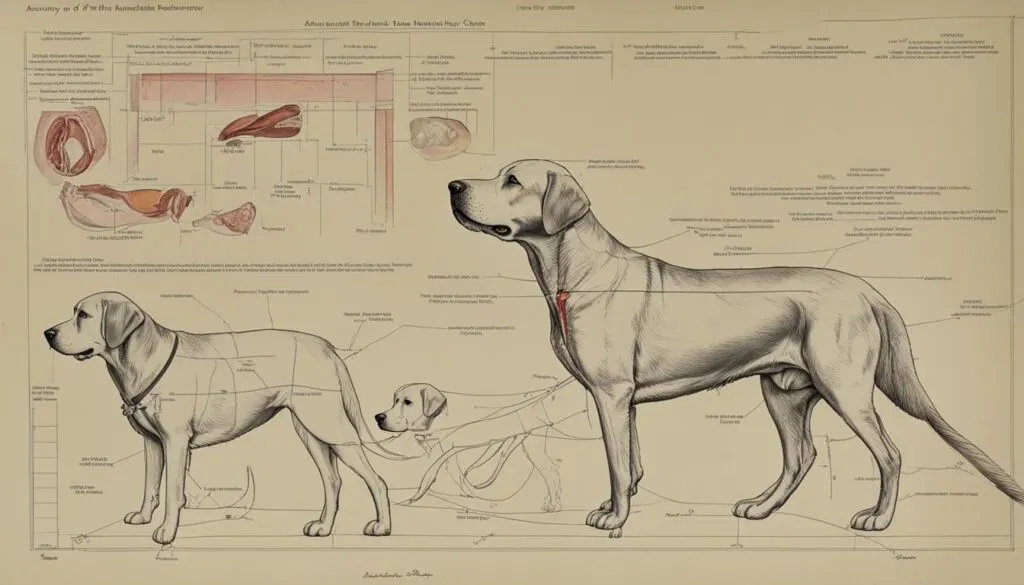Labrador Retrievers are popular and beloved companion dogs known for their friendly nature and intelligence.
As responsible pet owners, it is essential to have a thorough understanding of your Labrador’s reproductive health.
This includes being familiar with their heat cycle, which impacts their overall well-being and can influence breeding decisions.
The heat cycle, also known as the estrous cycle, is the reproductive cycle that female Labradors go through.
It is a natural process that occurs as part of their reproductive system’s preparation for potential pregnancy.

The heat cycle consists of different stages, each with its own characteristics and duration.
By gaining insight into these stages, you will be better equipped to provide appropriate care and attention to your female Labrador during this crucial time.
Understanding the heat cycle is also vital for those who are considering breeding their Labrador.
Click Here to Jump to a Section
Key Takeaways:
- The heat cycle, or estrous cycle, is a crucial aspect of a female Labrador’s reproductive health.
- Knowing the stages and duration of the heat cycle helps in managing your Labrador’s care during this time.
- Understanding the heat cycle is essential for responsible breeding decisions.
- Proper care and attention during the heat cycle contribute to the overall well-being of your Labrador.
- Stay informed and proactive in managing your Labrador’s reproductive health.
Recognizing the Signs of Heat in Female Labradors
During the reproductive cycle of female Labradors, there are distinctive physical and behavioral changes that indicate they are in heat.
Recognizing these signs is crucial for owners in order to provide appropriate care and address any possible breeding considerations.
Let’s take a closer look at the signs and symptoms that indicate a Labrador is in heat:
Physical Signs
- Swollen or Enlarged Vulva: One of the first noticeable signs of a lab in heat is a swollen or enlarged vulva. This occurs due to the increase in estrogen levels during the proestrus phase of the reproductive cycle.
- Changes in Urination Habits: Female Labradors may exhibit frequent urination or marking behavior during their heat cycle. This is a natural instinct to attract potential mates and is often accompanied by a strong odor.
- Vaginal Discharge: Labradors in heat may have a clear, straw-colored discharge that can gradually change to a pinkish or reddish color. This discharge is a result of hormonal changes and prepares the reproductive tract for potential fertilization.
- Behavioral Changes: Alongside the physical signs, Labradors may also display changes in behavior. These can include restlessness, increased affection or aggression, and seeking attention from male dogs.
Behavioral Signs
- Attracting Male Dogs: A female Labrador in heat will release pheromones that attract male dogs. Owners may observe an increase in male dogs showing interest and attempting to mate with their Labrador.
- Standing Heat: During the estrus stage, a Labrador may assume a characteristic mating posture known as “standing heat.” In this position, the female holds her tail wagged to the side, allowing a male dog to mount and mate with her.
- Changes in Energy Levels: Labrador retrievers in heat may experience fluctuations in energy levels. Some females become more lethargic, while others become more restless or hyperactive.
By familiarizing themselves with these signs, Labrador owners can better understand and manage their dog’s reproductive cycle.
Prolonged or irregular heat cycles, excessive bleeding, or any concerns should prompt a visit to a veterinarian for further evaluation and guidance.
Summary of Heat Cycle Signs and Symptoms
| Physical Signs | Behavioral Signs |
|---|---|
| Swollen or Enlarged Vulva | Attracting Male Dogs |
| Changes in Urination Habits | Standing Heat |
| Vaginal Discharge | Changes in Energy Levels |
The Stages of the Labrador Retriever Heat Cycle
Understanding the different stages of the Labrador retriever heat cycle is essential for any owner or breeder.
This cycle, also known as the canine heat cycle or the stages of the female dog heat cycle, consists of three distinct phases: proestrus, estrus, and diestrus.
1. Proestrus
Proestrus is the initial stage of the Labrador retriever heat cycle.
During this phase, which typically lasts for about 9-10 days, female Labradors may experience swollen vulva, bloody discharge, and behavioral changes.
However, they are not yet ready for breeding.
2. Estrus
The second stage of the Labrador retriever heat cycle is estrus, which is also commonly referred to as the “heat” stage.
It usually occurs around day 11-15 of the cycle and lasts for about 7-10 days.
Female Labradors are now fertile and receptive to mating.
They may exhibit more affectionate behavior, raise their tails when approached by males, and have a more prominent bloody discharge.
3. Diestrus
The final stage of the Labrador retriever heat cycle is diestrus, which follows estrus.
This stage lasts for approximately 60-90 days, regardless of whether or not the female Labrador has been bred.
During diestrus, the female dog’s reproductive system prepares for pregnancy.
If the Labrador retriever was successfully bred during estrus, she may become pregnant and enter the gestation period.
Determining the precise stage of the Labrador retriever heat cycle is crucial for responsible breeding and effective reproductive management.
By understanding the characteristics and duration of each stage, owners and breeders can ensure proper care and make informed decisions regarding breeding and health care for their female Labradors.

| Stage | Duration | Characteristics |
|---|---|---|
| Proestrus | 9-10 days | Swollen vulva, bloody discharge, behavioral changes |
| Estrus | 7-10 days | Fertile period, receptive to mating, more affectionate behavior, prominent bloody discharge |
| Diestrus | 60-90 days | Reproductive system preparation, potential pregnancy and gestation |
Labrador Retriever Breeding Patterns and Considerations
In this section, we will delve into the breeding patterns and considerations related to female Labradors in heat.
Understanding the Labrador Retriever breeding cycle is crucial for responsible breeding practices and ensuring the overall well-being of the dogs.
Prime Breeding Times
Female Labradors typically go into heat every six to twelve months, and each heat cycle consists of several stages.
The prime breeding time for Labradors is during the estrus stage, which usually occurs around the tenth to the fifteenth day of the heat cycle.
It is important to closely monitor your Labrador during this stage as it is when she is most fertile and receptive to mating.
It is crucial to consult with a veterinarian before proceeding with breeding.
They can provide guidance on determining the optimal time for mating and conducting necessary health screenings to ensure the Labrador’s suitability for reproduction.
Responsible Breeding Practices
Responsible breeding is essential to maintain the health and integrity of the Labrador Retriever breed. Before deciding to breed your Labrador, consider the following factors:
- The age and overall health of the Labrador: Breeding should only be done with adult Labradors that are in good health and free from genetic disorders.
- Genetic testing: Screening for inherited health conditions is crucial to prevent passing on genetic disorders to offspring. Tests can identify potential health risks and help make informed breeding decisions.
- Proper socialization and training: Ensuring that both the sire and dam have proper socialization and training will contribute to the overall temperament and well-being of the offspring.
- Financial and time commitment: Breeding and raising a litter of puppies require significant financial resources and time commitment. Responsible breeders should be prepared for the demands of caring for the dam during pregnancy, whelping, and raising the puppies.
- Breeding ethics: Responsible breeders adhere to ethical standards and breed to improve the breed rather than for financial gain. They prioritize the health, temperament, and conformation of the Labrador Retriever.
Considerations for Breeding a Labrador Retriever
| Considerations | Explanation |
|---|---|
| Health | Ensure both the sire and dam are in good health and free from genetic disorders. |
| Genetic Testing | Conduct genetic testing to identify potential health risks and make informed breeding decisions. |
| Socialization and Training | Ensure the sire and dam have proper socialization and training to contribute to the temperament of the offspring. |
| Financial and Time Commitment | Understand the financial resources and time commitment necessary for breeding and raising a litter of puppies. |
| Breeding Ethics | Breed responsibly, prioritize the health and conformation of the Labrador Retriever, and adhere to ethical standards. |
When considering breeding a Labrador Retriever, it is essential to prioritize the well-being of the breed and contribute to its overall health and quality.
Responsible breeding practices help maintain the breed’s integrity while producing healthy, well-rounded puppies.

Final Thoughts
Understanding the heat cycle in female Labradors is crucial for responsible pet ownership.
Throughout this article, we have explored the various aspects of the Labrador retriever heat cycle, from its stages to the signs and symptoms to watch out for.
By being informed about your Labrador’s reproductive cycle, you can ensure their well-being and take appropriate measures to manage their heat cycles effectively.
Recognizing the signs of heat in female Labradors is key to providing proper care and attention during this time.
From changes in behavior to physical manifestations, such as swelling and discharge, being aware of these signs allows you to adapt your care routine and provide the necessary support.
Moreover, understanding the breeding patterns and considerations related to female Labradors in heat is essential.
Responsible breeding practices, such as choosing the right breeding times and considering factors like the health and temperament of the Labrador, contribute to the overall well-being of the breed.
To prioritize the well-being and reproductive health of your Labrador retriever, it is crucial to stay informed and proactive.
By knowing the stages of their heat cycle, recognizing the signs, and making informed decisions about breeding, you can promote a healthy, happy life for your beloved Labrador companion.
